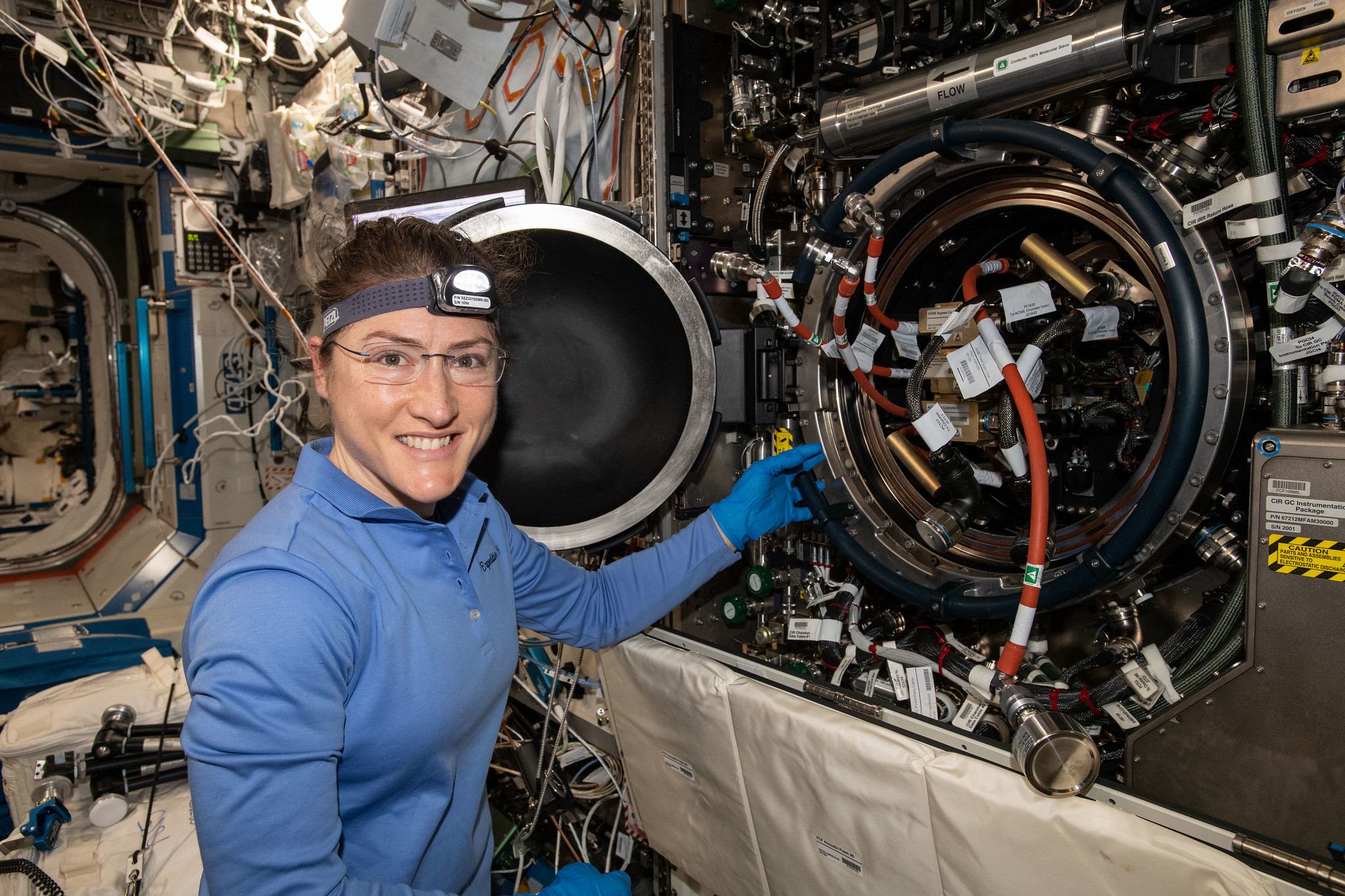NASA Astronaut Celebrates Women's Equality Day in Space at Midpoint of Record-Breaking Flight
She'll spend 328 days in space!
A NASA astronaut in the midst of a nearly year-long mission, the longest single flight by a woman, marked the midpoint of her journey Monday (Aug. 26) with a video celebration of Women's Equality Day and the female space pioneers who came before her.
American astronaut Christina Koch, who on her first spaceflight, is expected to spend 328 consecutive days in space during her trip to the International Space Station. She'll surpass the single-mission current record of 289 days set by NASA veteran astronaut Peggy Whitson in 2017. (Whitson will still holds the record for most accumulated time by a female over multiple missions, at 655 days.)
In her video speech on Twitter, Koch celebrated the women who fought for the right to vote in the early days of the 20th century. It was almost 100 years ago, she noted, that the 19th Amendment of the U.S. Constitution allowed female citizens to vote alongside male citizens. (The amendment's text reads, in part: "The right of citizens of the United States to vote shall not be denied or abridged by the United States or by any state on account of sex.")
Related: Women in Space: A Gallery of Firsts

"It is amazing and so meaningful to see how far we've come," Koch said while floating in the station's Japanese Kibo laboratory.
"I have truly been inspired by the struggle and triumphs of so many women that dare to break new ground in all aspects of society, and those who have pushed the boundaries of human imagination," Koch continued. "And now I am both privileged and challenged to have the opportunity to be a part of that story."
Koch's remarks were released on the same day as Women's Equality Day, and come as NASA pushes hard to put the first woman on the moon in 2024 as part of the Artemis program. Koch wished that person — as well as all other aspiring female record-breakers behind her — good luck.
Breaking space news, the latest updates on rocket launches, skywatching events and more!
Related: The Most Extreme Human Spaceflight Records
While women lag males in almost any spaceflight metric of note (such as time in space, number of spacewalks and number of people of one gender who have flown to space), there are many female milestones to celebrate:
Soviet cosmonaut Valentina Tereshkova was the first woman in space on June 16, 1963. At age 26 during her spaceflight, she remains the youngest person today to have ever flown in space.
NASA astronaut Sally Ride was the first U.S. female astronaut in space, almost exactly 20 years after Tereshkova – on June 18, 1983. After Ride's death in 2012, it was also revealed that she was the first known LGBTQ+ person to go to space.
The first female spacewalk by Soviet cosmonaut Svetlana Savitskaya was on July 25, 1984, outside the Salyut 7 space station. The first American woman to perform a spacewalk was Kathryn Sullivan on Oct. 11, 1984, outside space shuttle Challenger. Whitson holds the record for the largest number of spacewalks by a woman: 10 in all, across multiple missions.
- While there have been no all-female spacewalks yet, NASA tried to attempt one earlier in 2019 until a size issue with spacesuits forced a crew switch. Koch and NASA astronaut Anne McClain would have been the participants.
- Female NASA astronaut Susan Helms (along with male and fellow NASA astronaut Jim Voss) together hold the record for the longest spacewalk. It took place on March 11, 2001 outside the International Space Station, lasting 8 hours and 56 minutes.
- The largest number of women in orbit at the same time was four in April 2010. This happened during the STS-131 space shuttle mission. Its crew included three females (NASA's Stephanie Wilson, NASA's Dorothy Metcalf-Lindenburger and Japan's Naoko Yamazaki) who arrived at the International Space Station to meet NASA's Tracy Caldwell Dyson and the rest of the ISS crew.
- Earlier this year, on Feb. 22, Virgin Galactic astronaut trainer Beth Moses was the first woman on a commercial spaceflight to breach one entity's definition of space. She flew to an altitude of altitude of 55.87 miles (89.9 kilometers). This is beyond the U.S. Air Force-defined boundary of space of 50 miles (80 km), but below the International Astronautical Federation's defined space altitude of at 62 miles (100 km).
NASA officials have said that 59 women flew in space as of April 2017; today, that number stands at around 65.
In 2011, NASA launched Women@NASA, a website designed to celebrate and honor the women working in the U.S. space agency.
- The Human Body in Space: 6 Weird Facts
- Women in Space: A Gallery of Firsts
- The Spacewalks of Expedition 59 in Photos
Editor's note: This story has been updated to correct the number of total days of spaceflight astronaut Peggy Whitson has achieved. Follow Elizabeth Howell on Twitter @howellspace. Follow us on Twitter @Spacedotcom and on Facebook.
Join our Space Forums to keep talking space on the latest missions, night sky and more! And if you have a news tip, correction or comment, let us know at: community@space.com.

Elizabeth Howell (she/her), Ph.D., was a staff writer in the spaceflight channel between 2022 and 2024 specializing in Canadian space news. She was contributing writer for Space.com for 10 years from 2012 to 2024. Elizabeth's reporting includes multiple exclusives with the White House, leading world coverage about a lost-and-found space tomato on the International Space Station, witnessing five human spaceflight launches on two continents, flying parabolic, working inside a spacesuit, and participating in a simulated Mars mission. Her latest book, "Why Am I Taller?" (ECW Press, 2022) is co-written with astronaut Dave Williams.
